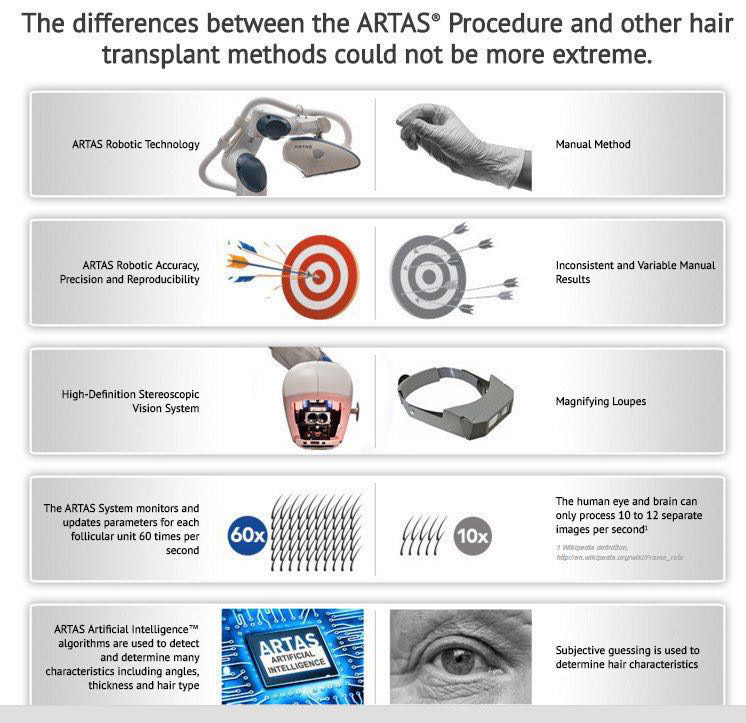
Half the hair transplantation process is technique and maintenance treatment, and the other half is the hairline design that has to be extremely artistic. I sometimes see patients of mine that have such a natural result I even can not tell they had a transplant! On the other hand so many unfortunate men and women go commercial and by trying to save money, they are stuck with a horribly artificial-looking hair over their head, or poor results.
Dany Touma, M.D.
Artas Robotic Hair Transplantation
Dr. Touma, founder of The Skin Clinic, is proud to have the first robotic device for follicular unit extraction (FUE) automated hair transplantation in the Middle East. The Artas® Robotic Hair Transplanation deviceallows physicians to give patients a permanent, fuller younger look while eliminating any drawbacks that may be associated with traditional transplant methods. In this minimally invasive procedure, each hair is targeted individually with robotic precision, adjusting for the angle and hence, avoiding the donor area long visible scar of strip surgery and replacing it with tiny scars that are much less visible. Although in our experienced hands manual FUE can give excellent results, it typically requires manual punching of thousands of grafts, which inevitably can be fatiguing after some time. Robotic hair transplant overcomes this problem as graft quality remains consistent throughout the procedure keeping human factors out.
Artas’ innovative approach to hair transplantation starts during the consultation stage. Using photographs of the patient’s head, ARTAS® Hair Studio Technology creates a customized 3D model of the transplant design, allowing the patient to see and adjust the end results beforehand. Because every patient’s requirements are different, ARTAS® Hair Studio Technology enables the physician to show the patient the final outcome, including number of hair grafts required, direction of the implanting final hair style, allowing the physician to achieve the results the patient wants, and eliminating any guesswork. Artas’s advanced technologies offer patients an unpreceded accuracy in designing and implementing the desired result. This virtual hair studio shows the patient the end result. This hair design plan is transmitted to the digitized harvesting and robotic site creation to produce an accurate result that is identical to the virtual pictures shown to the patient.
Robotic FUE hair transplantation device
With the help of its 3D photograph-based simulation, patients can contribute to designing their desired aesthetic result while they see the simulated hairline in front of them on the computer screen. The robot identifies and selects optimal hairs for harvesting from the donor area and skips suboptimal ones including white hair if undesired. At the recipient site, Artas® rapidly executes the ideal hair pattern under physician supervision, while avoiding damaging pre-existing healthy hairs. Consistency is maintained as there is no repetitive manual task like with manual transplants.
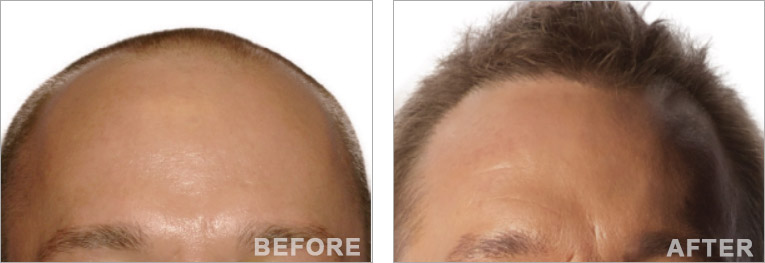
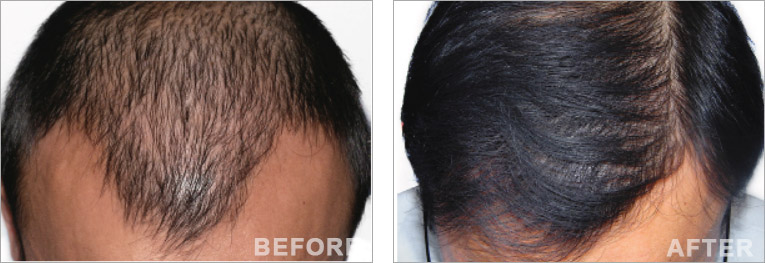
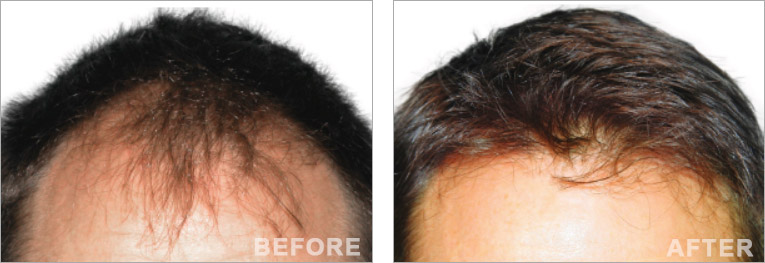
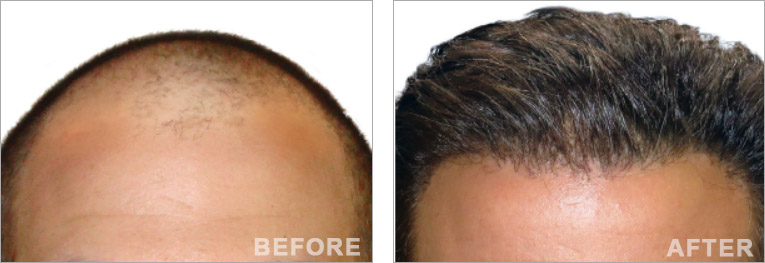
Robotic FUE hair transplantation results
Manual Hair Transplantation Using Strip and FUE
At The Skin Clinic, we use the most refined implantation techniques to provide superb results for even the most challenging cases and areas including eyebrows, beard, and moustache or scarred areas.
The hair is taken from the back of the scalp were hairs are usually abundant, as tiny follicular units (FUEs) that are extracted one at a time. In some cases where it is in the best interest of the patient, for example women or men with long hair who cannot shave their head for the FUE procedure to be performed, a strip is removed from this area and stitched in a very refined way, leaving an almost invisible scar only 1mm wide. The hairs are then prepared and separated under the microscope and reimplanted into the balding areas in the form of micrografts. Dr Touma specializes in micrografting, which is the implantation of single hairs one at a time to obtain the most naturally looking hairline. The whole procedure is done under local anesthesia and with very little inconvenience post operatively. One or two sessions are generally enough for most people. The eyebrows, beard, and moustache, sideburns (especially after face lift surgery) and other areas of the body as well as hair loss from burn and other scars can be treated.
Donor site:
Selecting a good donor area is very important for a successful transplant. Hairs are usually taken from the back of the scalp which is not subject to hair balding, and will re-grow back to normal length after the procedure.
Strip versus FUE:
Traditional hair transplantation involves removing a strip of permanent hair-bearing skin from the donor site. The strip is closed in a most refined way with sutures and heals as a very thin line of approximately 1 mm that is covered by hair 3 mm or longer.
Follicular Unit Extraction (FUE) is a newer technique whereby hair is removed from the donor back area of the scalp using a very small punch technique, instead of removing a strip. The donor area heals with no linear scar, and only small white points remain, that are covered with hair 1 mm or longer.
Dr Touma has the expertise and refined technical skills to perform both strip and FUE techniques, the preference of which is determined on a case to case basis. FUE is a preference for patients who don’t want a scar in the back of the head or are surgery-phobic, while a strip allows the transplantation of more total hair overall in a single session. Also with FUE, the donor area needs to be shaved while hair is left long for the strip technique and covers the linear scar in the early days post-op.
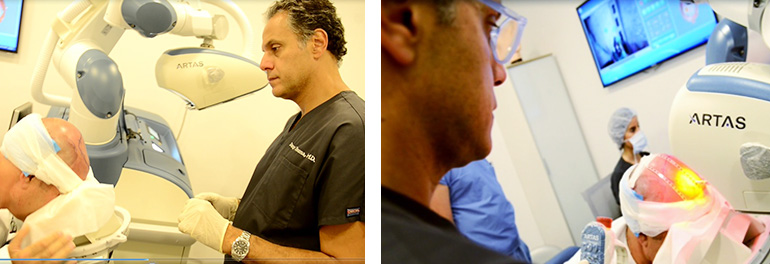
No Shave FUE
No shave FUE is a technique that allows patients to have FUE’s without shaving their head totally. Small areas of the scalp are shaved and are scattered throughout the donor area in the sides and back of the head. The FUE’s are delicately removed, and the long unshaved hair covers those areas. Up to 800-1000 grafts can be removed this way, which is sufficient for smaller transplant cases. For larger cases, the no-shave FUE technique can be repeated monthly over time to achieve a large number of transplanted hairs.
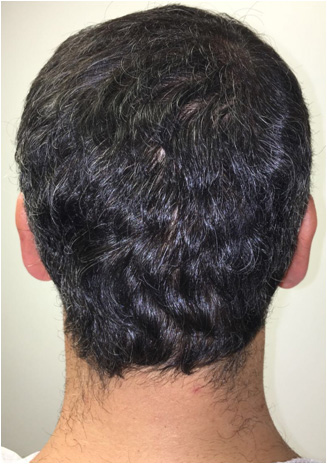
Do it right the first time
Many commercial hair transplantation centers advertise heavily, promoting very cheap fees. Patients often travel to these countries and return with unsatisfactory results, due to poor technique or wrong hairline placement or both, leading to a ’transplanted look’. If it sounds to good to be true, it usually is. A hair transplant is a lifetime decision, and will last forever. Good medicine is costly, particularly when technology is involved. Dr Touma has not only perfected the technical and medical aspect of personalized hair restoration, he has a keen sense of elegance that will guarantee you a very natural hair transplant, at fees that are very reasonable compared to other world class practices. Patients are usually looking so natural, even hair transplant surgeons cannot guess they had any work done and this is priceless!
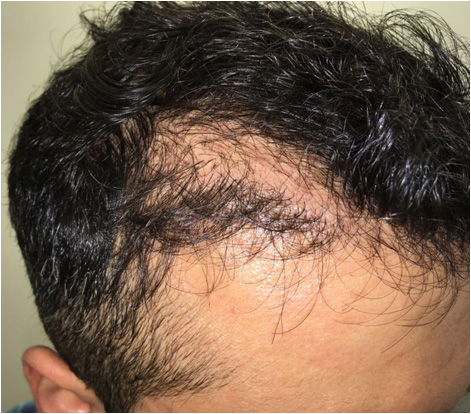
This patient was treated in a commercial center in another country and was given a low hair line that is too low and wide without taking into account the continuous aspect of hair loss. He is seen 1 year later with an unnatural appearance and urgently needs another procedure.

This patient, treated elsewhere, had implants in the temples. On his right side the hair line unnaturally low, on the left side, no hair grew.
This patient had a manual FUE at a commercial center, with a failed result. You can see that while a large number of FUEs was harvested in the donor area in the back of the head, very few hairs actually grew in the recipient area in the frontal scalp, evidence of a poor technique causing a lot of damaged grafts that eventually don’t grow. Robotic harvesting ensures that all the harvested grafts will grow, making it worth the extra cost.

